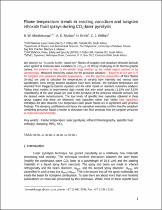 ResearchSpace
ResearchSpace
Flame temperature trends in reacting vanadium and tungsten ethoxide fluid sprays during CO2-laser pyrolysis
JavaScript is disabled for your browser. Some features of this site may not work without it.
- ResearchSpace
- →
- Research Publications/Outputs
- →
- Journal Articles
- →
- View Item
| dc.contributor.author |
Mwakikunga, Bonex W

|
|
| dc.contributor.author |
Mudau, AE

|
|
| dc.contributor.author |
Brink, N

|
|
| dc.contributor.author |
Willers, Cornelius J

|
|
| dc.date.accessioned | 2011-11-09T11:17:52Z | |
| dc.date.available | 2011-11-09T11:17:52Z | |
| dc.date.issued | 2011-09 | |
| dc.identifier.citation | Mwakikunga, BW, Mudau, AE et al. 2011. Flame temperature trends in reacting vanadium and tungsten ethoxide fluid sprays during CO2-laser pyrolysis. Applied Physics B: Lasers and Optics, Vol 105(2011), pp 451–462 | en_US |
| dc.identifier.issn | 0946-2171 | |
| dc.identifier.issn | 1432-0649 | |
| dc.identifier.uri | http://www.springerlink.com/content/b86k54v072463h70/fulltext.pdf | |
| dc.identifier.uri | http://hdl.handle.net/10204/5279 | |
| dc.description | Copyright: 2011 Springer. This is the post print version of the work. The definitive version is published in Applied Physics B: Lasers and Optics, Vol 105, pp 451-462 | en_US |
| dc.description.abstract | We observe the “invisible-to-the- naked-eye” flames of tungsten and vanadium ethoxide aerosols when ignited at moderate laser excitation (0 < Plaser< 70 W) by employing an IR thermo-graphic camera. No emission is seen in the visible range whether by the visible region cameras or by spectroscopy. Measured emissivity values for the precursor solutions – found to be 0.8 and 0.75 for tungsten and vanadium ethoxide respectively – and the spectral emissivities of their flames (in-situ) are used to calculate the temperatures at varying laser intensity and various laser wavelengths. New energy balance equations have been derived –the transient temperature one extended from Haggerty-Cannon equation and the other based on standard resonance analysis. Fitting these models to experimental data reveals that only small amounts (1.33% and 4.32% respectively) of the laser power are used in the pyrolysis of the precursor ethoxide aerosols into the desired oxide nanostructures. The low levels of specific heat capacities obtained in these sprays suggest that these are electronic heat capacities rather than lattice heat capacities; enthalpies are also obtained. Our temperature-laser power trends are in agreement with previous findings. The damping coefficients and hence the saturation intensities confirm that the vanadium containing precursor liquid is harder to dissociate into final products than the tungsten precursor as observed experimentally. | en_US |
| dc.language.iso | en | en_US |
| dc.publisher | Springer Verlag (Germany) | en_US |
| dc.relation.ispartofseries | Workflow request;7463 | |
| dc.subject | Flame temperature | en_US |
| dc.subject | Laser pyrolysis | en_US |
| dc.subject | Infrared thermography | en_US |
| dc.subject | Specific heat | en_US |
| dc.subject | Enthalpy | en_US |
| dc.subject | Damping | en_US |
| dc.subject | WO3 | en_US |
| dc.subject | VO2 | en_US |
| dc.title | Flame temperature trends in reacting vanadium and tungsten ethoxide fluid sprays during CO2-laser pyrolysis | en_US |
| dc.type | Article | en_US |
| dc.identifier.apacitation | Mwakikunga, B. W., Mudau, A., Brink, N., & Willers, C. J. (2011). Flame temperature trends in reacting vanadium and tungsten ethoxide fluid sprays during CO2-laser pyrolysis. http://hdl.handle.net/10204/5279 | en_ZA |
| dc.identifier.chicagocitation | Mwakikunga, Bonex W, AE Mudau, N Brink, and Cornelius J Willers "Flame temperature trends in reacting vanadium and tungsten ethoxide fluid sprays during CO2-laser pyrolysis." (2011) http://hdl.handle.net/10204/5279 | en_ZA |
| dc.identifier.vancouvercitation | Mwakikunga BW, Mudau A, Brink N, Willers CJ. Flame temperature trends in reacting vanadium and tungsten ethoxide fluid sprays during CO2-laser pyrolysis. 2011; http://hdl.handle.net/10204/5279. | en_ZA |
| dc.identifier.ris | TY - Article AU - Mwakikunga, Bonex W AU - Mudau, AE AU - Brink, N AU - Willers, Cornelius J AB - We observe the “invisible-to-the- naked-eye” flames of tungsten and vanadium ethoxide aerosols when ignited at moderate laser excitation (0 < Plaser< 70 W) by employing an IR thermo-graphic camera. No emission is seen in the visible range whether by the visible region cameras or by spectroscopy. Measured emissivity values for the precursor solutions – found to be 0.8 and 0.75 for tungsten and vanadium ethoxide respectively – and the spectral emissivities of their flames (in-situ) are used to calculate the temperatures at varying laser intensity and various laser wavelengths. New energy balance equations have been derived –the transient temperature one extended from Haggerty-Cannon equation and the other based on standard resonance analysis. Fitting these models to experimental data reveals that only small amounts (1.33% and 4.32% respectively) of the laser power are used in the pyrolysis of the precursor ethoxide aerosols into the desired oxide nanostructures. The low levels of specific heat capacities obtained in these sprays suggest that these are electronic heat capacities rather than lattice heat capacities; enthalpies are also obtained. Our temperature-laser power trends are in agreement with previous findings. The damping coefficients and hence the saturation intensities confirm that the vanadium containing precursor liquid is harder to dissociate into final products than the tungsten precursor as observed experimentally. DA - 2011-09 DB - ResearchSpace DP - CSIR KW - Flame temperature KW - Laser pyrolysis KW - Infrared thermography KW - Specific heat KW - Enthalpy KW - Damping KW - WO3 KW - VO2 LK - https://researchspace.csir.co.za PY - 2011 SM - 0946-2171 SM - 1432-0649 T1 - Flame temperature trends in reacting vanadium and tungsten ethoxide fluid sprays during CO2-laser pyrolysis TI - Flame temperature trends in reacting vanadium and tungsten ethoxide fluid sprays during CO2-laser pyrolysis UR - http://hdl.handle.net/10204/5279 ER - | en_ZA |





